Meteors streak across the sky over a desert during the Orionid meteor shower on Oct. 22, 2023 in Yuli County, Bayingolin Mongol Autonomous Prefecture, Xinjiang Uygur Autonomous Region of China.
VCG/VCG via Getty Images
August’s Perseid meteor shower, often referred to as the best of the year, was somewhat outshined by the moon. If your viewing experience wasn’t quite what you expected, there’s some good news: This week’s Orionid meteor shower peaks during a new moon, enhancing the sight with a dark sky.
Here’s what to know about the Orionids and how to watch the peak on Monday and Tuesday nights.
Article continues below this ad
Meteors streak across the sky over a desert during the Orionid meteor shower on Oct. 22, 2023 in Yuli County, Bayingolin Mongol Autonomous Prefecture, Xinjiang Uygur Autonomous Region of China.
VCG/VCG via Getty Images
What is the Orionid meteor shower?
The Orionid meteor shower is an annual astronomical event featuring some of the fastest meteors. The meteors are a stream of debris from Halley’s Comet, which the Earth hits in its rotation around the sun.
Despite the meteors’ source, Halley’s Comet will remain unseen from Earth until July 2061 (it last passed near the Earth in February 1986). It’s among the most famous comets, because it marks a significant discovery. NASA reports that in the 18th century, English astronomer Edmond Halley was the first to prove the same comet could repeatedly pass by the Earth. He proposed that similar sightings recorded in 1531, 1607 and 1682 were actually the same comet completing its 76-year journey around the sun.
Article continues below this ad
On average the Orionids travel at 41 miles per second, according to Space.com — or 147,600 miles per hour. They are named after the Orion constellation, from which they appear to originate in the sky.
What time is the Orionid meteor shower?
While the Orionid meteor shower has been active since Oct. 2 and will continue through Nov. 7, it will peak on the nights of Oct. 20-23. Tonight’s new moon will offer particularly clear views. Once at its peak, up to 20 meteors an hour will be visible.
Article continues below this ad
Ideal viewing of the Orionids will occur between midnight and dawn in the early hours of Oct. 21-23, per the American Meteor Society.
Where to see the Orionid meteor shower in 2025
The Orionid meteor shower will appear in the southeast sky near the Orion constellation.
Sky chart showing the Orionid meteor shower, including the radiant point of the shower and the Orion constellation where the meteors in the shower are often seen and stem from.
NASA/JPL-Caltech
No special equipment, telescope or binoculars will be necessary to see the meteors. Experts recommend finding a dark viewing spot, away from city lights, 20 to 30 minutes prior to the shower to allow your eyes to adjust. You should also avoid looking at phones and other bright lights during this period.
Article continues below this ad
What is the weather forecast?
A cold front is expected to move across Texas on Tuesday. Ahead of its arrival, clouds will gradually increase overnight, making skies mostly cloudy by sunrise Tuesday morning.
Clouds will increase ahead of a cold front on Tuesday morning. This graphic shows the expected cloud cover at 5 a.m.
Pivotal
Fortunately, during the peak viewing time around 2 a.m., skies could still be partly clear, with only about 20% cloud cover. By 5 a.m., cloud coverage is forecast to increase to around 60%. Winds will remain light, coming from the south-southwest at 5 to 10 mph, shifting to the west and northwest by sunrise at 7:37 a.m. Temperatures will remain mild and dipping into only the low 70s.
Article continues below this ad
During the second “peak” on Tuesday night, the clouds will move in a little earlier with a mostly cloudy sky in the Hill Country and in Austin by 3 a.m. and continue through sunrise on Wednesday.
Clouds will arrive earlier Tuesday night, which may interfere with viewing the Orionid Meteor Shower during its second peak around 2 a.m. on Wednesday morning.
Pivotal


